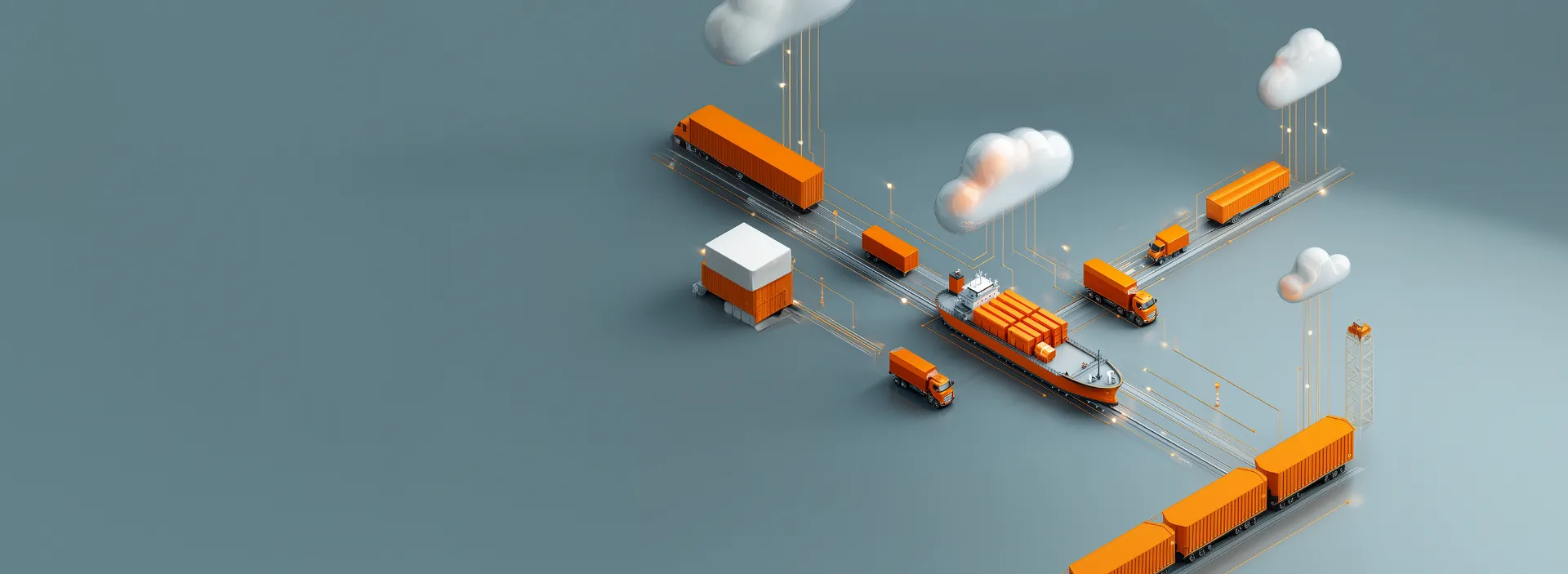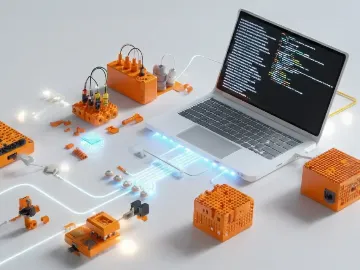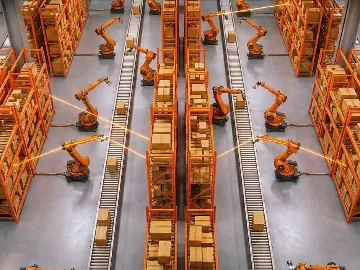A decade ago, fleet supervisors relied on clipboards, two-way radios, and yesterday's fuel receipts to understand where vehicles had been and how they were performing. An unexpected breakdown could idle half a day's deliveries, and route changes meant phoning each driver and hoping traffic hadn't already snarled. The Internet of Things (IoT) technology has changed this scenario for good.
With IoT fleet management solutions featuring GPS sensors, engine monitors, and cloud dashboards, the same supervisor sees every truck, trailer, and container in real time, along with engine health, cargo temperature, and driver behaviour metrics. How does it impact business, and most importantly, how can one ensure successful IoT deployments for fleet management solutions? Let's explore.
What is IoT in fleet management?
IoT fleet management combines IoT technology with management systems to monitor and optimize fleet operations, streamline logistics, and ensure regulatory compliance. The connected network gathers real-time data on vehicle location, condition, engine health, and driver behavior through sensors and telematics. Modern IoT solutions for fleet management go beyond basic GPS tracking to provide comprehensive connectivity and intelligent features.
IoT-based tools help fleet managers:
- Improve vehicle performance;
- Plan efficient routes;
- Enhance safety measures;
- Optimize fuel consumption.
The result is increased productivity, smarter decision-making, and more cost-efficient fleet operations. Here's how IoT and fleet management work together.
Key components of the IoT and fleet management ecosystem
An IoT fleet management system usually consists of six key components:
- Vehicle and environment sensors;
- Telematics gateway;
- IoT connectivity;
- IoT and data platform;
- Analytics and AI;
- User interfaces.
IoT-connected vehicles and sensors use embedded or tethered systems for connectivity, transmitting data like idle time and braking via cellular or satellite networks to cloud platforms. These platforms, often integrated with AI tools, analyze the data, flag anomalies, and suggest maintenance or faster routes. Establishing vehicle-to-everything (V2X) communication allows vehicles to interact with infrastructure, pedestrians, other vehicles and networks. This data can be used for predictive analytics to provide fleet managers with actionable insights to prevent breakdowns and optimize operations.
Let's review the components, function, and typical tech for creating the IoT-based fleet management ecosystem.
| Component | Function | Typical tech |
|
Vehicle & environment sensors |
Capture GPS, engine health, cargo temperature, tyre pressure, driver actions, etc. |
GNSS modules, OBD-II/CAN taps, temperature probes |
|
Telematics gateway |
Aggregate, preprocess, and encrypt sensor and device data |
On-board Linux/RTOS gateway, MQTT/HTTP(S) publishers |
|
Connectivity |
Move data to the cloud (including real-time data) |
4G/5G, LPWAN, satellite or non-terrestrial network (NTN), Wi-Fi, Bluetooth, etc. |
|
IoT & data platform |
Device lifecycle, sensor data analytics, data storage |
AWS IoT Core, Azure IoT Hub, Google Cloud IoT, ThingWorx, etc. |
|
Analytics & AI |
Turn raw telemetry into alerts and predictions |
Stream processing, predictive maintenance models, route optimization engines |
|
User interfaces |
Visualize IoT data and provide insight for the managers and drivers |
Web consoles, mobile apps, in-cab tablets, ERP/MES connectors, etc. |
Internet of Things in fleet management helps businesses connect their fleet assets and stream data from the sensors and devices directly into the management system. Here are a few use cases where IoT technology in fleet management can be effective.
You may also be interested in: Logistics app development: Best practices for implementation
Top IoT fleet management use cases
- Real-time vehicle tracking. IoT devices like GPS sensors and telematics transmit real-time vehicle location data, allowing fleet managers to monitor movements and optimize routes.
- Predictive maintenance. Sensors embedded in the vehicle track engine's KPI, such as engine temperature and vibrations, send data into analytics platforms to predict mechanical failures before they occur.
- Fuel management. IoT sensors monitor fuel consumption and idle time, providing fleet managers with insights into fuel efficiency.
- Driver behavior analysis. IoT-enabled telematics systems track driver actions such as speeding, braking, and cornering to provide real-time feedback and improve safety.
- Cargo monitoring. IoT sensors track environmental conditions like temperature, humidity, and vibration inside cargo holds, ensuring products, especially perishable goods, stay within safe parameters during transit.
- Regulatory compliance. IoT in fleet management solutions allows ELDs and sensors to automatically collect and transmit data on driver hours, emissions, and other metrics.
- Asset tracking. IoT-enabled tags on trailers and containers transmit real-time location and movement data, improving the visibility and utilization of all fleet assets.
Explore 6 disruptive IoT trends for 2026 and beyond—get the guide!
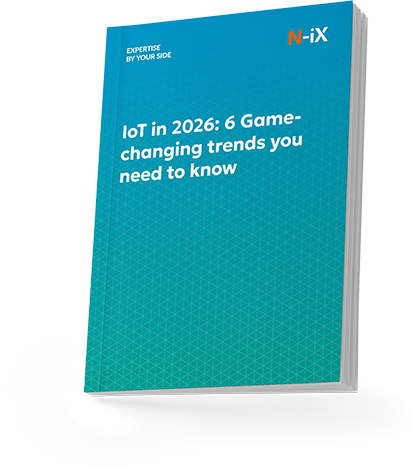

Success!

Fleet managers who implement IoT see operational improvements across multiple areas. Industry data shows that businesses using this tech achieve IoT fleet management benefits after implementation. Let's review them.
Top 8 benefits of IoT for fleet management
According to Viasat's "The State of Industrial IoT in 2024" report, the respondents mentioned the increase in their IoT investments to integrate IoT solutions with vehicular tracking and route optimization, shipment and supply chain tracking, cold chain tracking, and people tracking systems [1].
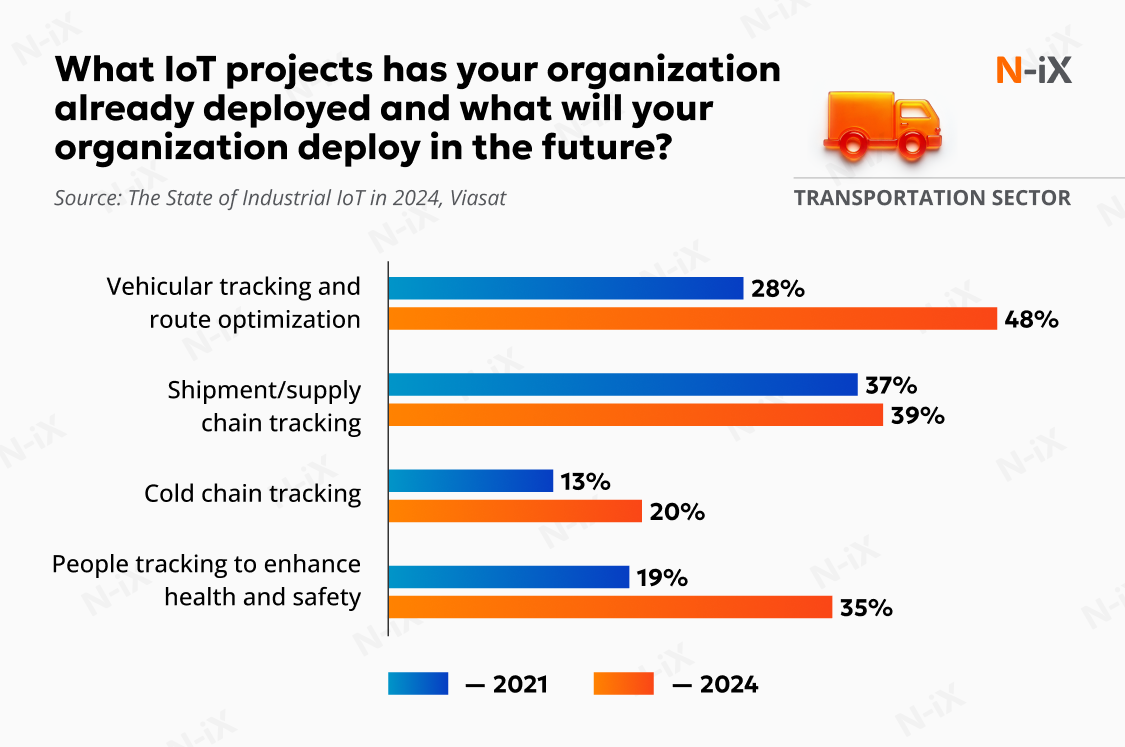
Moreover, the surveyed businesses linked increased business and operational efficiency (70%), better decision-making (69%), and improved cyber and physical security (69%) to their IoT adoption. And these aren't the only ways in which the Internet of Things in fleet management can pay off.
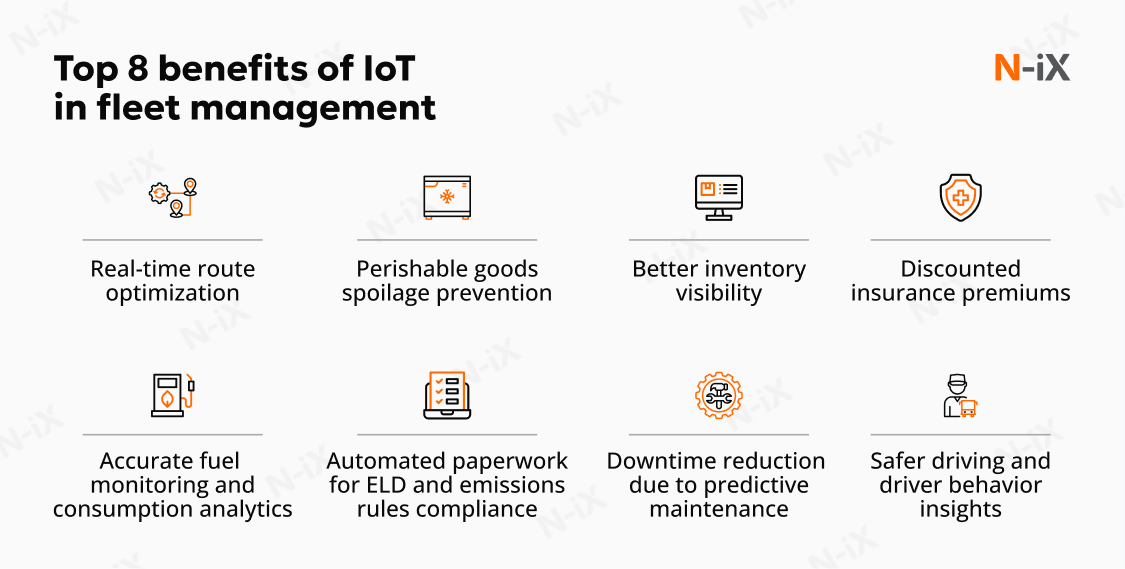
Real-time route optimization
GPS tracking with real-time traffic data enables dynamic route adjustments. This reduces travel distance and transit times. In addition, fleet managers receive immediate updates on vehicle locations, allowing quick rerouting due to traffic or weather conditions. These optimizations lead to significant cost savings in fuel expenses through optimized routing. Moreover, it contributes to safer delivery and driving.
Accurate fuel and battery level monitoring and consumption analytics
IoT-enabled fuel and battery level monitoring systems track consumption patterns, idle time, and engine or battery performance to identify inefficiencies. Fleet managers gain visibility into:
- Actual MPG performance versus targets;
- Fuel used during idling;
- Battery energy consumption;
- The engine malfunctions, affecting efficiency.
These insights help reduce overall fuel costs, which often represent the majority of fleet operating expenses.
At N-iX, we've worked on one of the IoT fleet management use cases for developing a solution for fleet management with fuel monitoring features. We helped one of our clients, a Belgium-based international company developing telematics solutions, create a new solution for streamlining and optimizing fleet management processes. One of the key tasks was to create a feature that would allow users to monitor vehicle travel speed, fuel consumption, engine performance, and more.
N-iX's IoT engineers helped develop an OEM-based Linux connectivity gateway to enable data transmission. In addition, we assisted in system integration with the GCP IoT platform, which is powered by a complex analytics engine, to enable predictive analytics and fuel consumption optimization. As a result, our clients improved their fleet management and were able to engage new clients by offering a feature-packed tech solution.
Curious what it takes to find a reliable tech partner? Check out our guide to finding a top logistics software development company
Downtime reduction due to predictive maintenance
IoT sensors continuously monitor engine temperature, vibration patterns, and fluid levels to forecast potential failures. This proactive approach reduces unplanned downtime and minimizes emergency repairs that disrupt operations. In addition, implementing predictive maintenance allows fleet managers to identify underperforming trucks before critical failures occur.
Safer driving and driver behavior insights
Telematics data captures driving actions: speeding, harsh braking, rapid acceleration, and cornering. This provides insights into driving habits that affect drivers' safety and performance. Fleets using IoT fleet management for advanced driver behavior monitoring can decrease speeding and aggressive driving incidents. In addition, this monitoring can reduce collision incidents and enhance driver alertness through real-time communication with the fleet managers.
Automated paperwork for ELD and emissions rules compliance
IoT-powered Electronic Logging Devices (ELDs) automatically record driving hours, eliminating manual paperwork and reducing errors. This automation simplifies compliance with the regulations enforced by the Federal Motor Carrier Safety Administration (FMCSA) or similar transport authority regarding Hours of Service and ELD record keeping. As a result, fleet operators and vehicle drivers can avoid fines associated with violating reporting requirements.
Ready to start your fleet management project? Explore top IoT software development companies that transform businesses
Perishable goods spoilage prevention
For temperature-sensitive products, IoT sensors provide continuous temperature monitoring throughout transport. The system includes sensors that measure temperature in real time. It's connected to a platform that sends alerts if conditions deviate from safe ranges. This prevents product spoilage and rejected deliveries, which often happen in the pharmaceutical and food industries.
Better inventory visibility
IoT tracking extends to non-powered assets like trailers, containers, and equipment. Battery life trackers monitor these assets with features like tamper alerts and motion detection. This visibility reduces the time needed to locate equipment and improves asset utilization across the transportation, construction, and utilities industries. Moreover, it prevents asset loss that can burden delivery and logistics.
Discounted insurance premiums
Insurance telematics applies telematics technology to auto insurance, collecting driving data that insurers use to assess risk and set premiums. Companies using these systems often see reductions in insurance premiums as their claims history improves. Telematics data provides comprehensive evidence before, during, and after incidents, offering clear pictures of circumstances that can help reduce insurance costs.
While IoT brings remarkable benefits to fleet management, the adoption process can present several challenges for businesses.
Challenges of adopting IoT fleet management
- Upfront investment. Implementing IoT solutions requires significant hardware, software, and network infrastructure costs. It can be a barrier for businesses with limited capital or tight budgets.
- Integration complexity. IoT systems often need to be integrated with existing fleet management software and infrastructure, which may require extensive customization and may lead to unexpected delays or additional expenses.
- Gateway to cloud connectivity. Ensuring that IoT devices, gateways, and telematics units are fully compatible with the chosen cloud platform can be complex, especially when integrating hardware from multiple vendors. On top of that, maintaining secure and reliable data transmission requires continuous monitoring and protection against evolving cyber threats.
- Disparate data. IoT systems generate vast amounts of real-time data, which can overwhelm businesses that lack the tools and resources to process and analyze this information effectively. Proper storage, data processing, and insightful analysis are critical to making IoT data actionable.
- Ongoing maintenance and updates. Regular maintenance, firmware updates, and ensuring the security of connected devices are crucial for the continued success of IoT solutions. Without proper management, devices could become outdated or vulnerable.
Despite these challenges, IoT in fleet management can significantly improve operations if properly implemented. With our experience in IoT and embedded software development, N-iX helps fleet management companies streamline their logistics with advanced technology tailored to their specific needs. Read on how.
Reach IoT fleet management benefits with N-iX
By leveraging our expertise in firmware development, cloud solutions, connected device engineering, AI, data analytics, computer vision, and other technologies, we help our clients gain real-time insights into vehicle health, driver behavior, and operational efficiency.
Our IoT fleet management offering include:
- IoT sensor and device integration;
- IoT fleet management infrastructure design;
- IoT security services;
- IoT-based predictive maintenance solution development;
- Telematics integration;
- Fleet data management and IoT visualization;
- Mobile and wearable IoT app development;
- Integration with third-party systems;
- Automated QA for fleet management IoT.
With over 23 years of experience and more than 2,400 skilled tech experts, N-iX helps you develop robust IoT solutions to address fleet management challenges of your business.
Final thoughts
As IoT continues to transform fleet management, businesses that adopt these technologies are seeing tangible improvements in efficiency, cost reduction, and operational optimization. However, implementing IoT solutions can be complex, requiring careful planning, integration, and maintenance.
Partnering with an experienced IoT consulting firm like N-iX ensures that your fleet management system will be custom-designed to meet your unique business needs and deliver measurable results. Contact us to discuss how our knowledge and skills can contribute to your business's growth.
Sources:
- The State of Industrial IoT in 2024 | Viasat
Have a question?
Speak to an expert
